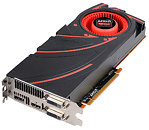- Joined
- Oct 9, 2007
- Messages
- 47,537 (7.47/day)
- Location
- Hyderabad, India
| System Name | RBMK-1000 |
|---|---|
| Processor | AMD Ryzen 7 5700G |
| Motherboard | ASUS ROG Strix B450-E Gaming |
| Cooling | DeepCool Gammax L240 V2 |
| Memory | 2x 8GB G.Skill Sniper X |
| Video Card(s) | Palit GeForce RTX 2080 SUPER GameRock |
| Storage | Western Digital Black NVMe 512GB |
| Display(s) | BenQ 1440p 60 Hz 27-inch |
| Case | Corsair Carbide 100R |
| Audio Device(s) | ASUS SupremeFX S1220A |
| Power Supply | Cooler Master MWE Gold 650W |
| Mouse | ASUS ROG Strix Impact |
| Keyboard | Gamdias Hermes E2 |
| Software | Windows 11 Pro |
In a bid to counter NVIDIA's bestselling GeForce GTX 760, AMD is preparing a new 28 nm GPU, codenamed "Tonga," as detailed in our older article on the chip. At the time of its writing, we had two theories on what "Tonga" could be, one held that it could be a counter to the GM107, and the other, that's is a step above "Curacao," in a bid to counter the GTX 760. We're now learning that AMD could launch the first graphics cards based on this chip, some time in August. The chip will replace the ailing "Tahiti Pro" silicon, from which is carved out the Radeon R9 280. While the R9 280 offers performance competitive to the GTX 760, it loses out big time on power consumption and heat. The cheaper R9 270X, on the other hand, offers lower performance, and similar power levels. "Tonga" could offer nearly as much performance, while featuring a new combination of components, that help AMD lower not just power draw, but also overall costs.
The 28 nm "Tonga" silicon is expected to feature 2,048 GCN2 stream processors, 128 TMUs, 32 ROPs, and a 256-bit wide GDDR5 memory interface. You'll notice that its memory interface is narrower than that of the R9 280, but performance is made up for with a higher stream processor count, and probably higher clock speeds, too. The card could come in memory capacities of 2 GB, with some manufacturers innovating 4 GB variants. There's no word on what the company could end up naming the first cards running this chip.

View at TechPowerUp Main Site
The 28 nm "Tonga" silicon is expected to feature 2,048 GCN2 stream processors, 128 TMUs, 32 ROPs, and a 256-bit wide GDDR5 memory interface. You'll notice that its memory interface is narrower than that of the R9 280, but performance is made up for with a higher stream processor count, and probably higher clock speeds, too. The card could come in memory capacities of 2 GB, with some manufacturers innovating 4 GB variants. There's no word on what the company could end up naming the first cards running this chip.

View at TechPowerUp Main Site






